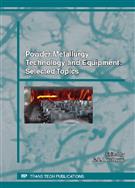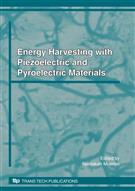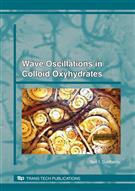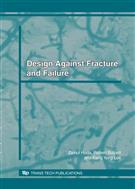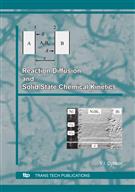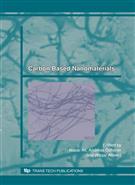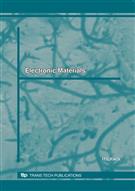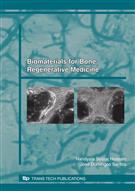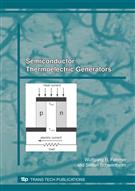Engineering Research
Advanced Engineering Forum
Applied Mechanics and Materials
Engineering Chemistry
Engineering Innovations
Journal of Biomimetics, Biomaterials and Biomedical Engineering
International Journal of Engineering Research in Africa
Materials Science
Advanced Materials Research
Defect and Diffusion Forum
Diffusion Foundations and Materials Applications
Journal of Metastable and Nanocrystalline Materials
Journal of Nano Research
Key Engineering Materials
Materials Science Forum
Nano Hybrids and Composites
Solid State Phenomena
Engineering Series
Advances in Science and Technology
Construction Technologies and Architecture
Engineering Headway
Foundations of Materials Science and Engineering
Volume in the series: 74
Authors:
Zainul Huda and Robert Bulpett
Volume is indexed by Thomson Reuters BCI (WoS).
The uniqueness of the title of this book, Materials Science and Design for Engineers, already indicates that the authors - professionals having over 30 years of experience in the fields of materials science and engineering - are here tackling the rarely-discussed topic of the science of materials as directly related to the domain of design in engineering applications. This comprehensive textbook has now filled that gap in the engineering literature.
The uniqueness of the title of this book, Materials Science and Design for Engineers, already indicates that the authors - professionals having over 30 years of experience in the fields of materials science and engineering - are here tackling the rarely-discussed topic of the science of materials as directly related to the domain of design in engineering applications. This comprehensive textbook has now filled that gap in the engineering literature.
eBook:
$165.00
Volume in the series: 73
Authors:
G.S. Upadhyaya
Volume is indexed by Thomson Reuters BCI (WoS).
Powder metallurgy is one of the leading processes used for forming engineering components. The technology, as developed at the beginning of the 20th century, has since advanced significantly from both the materials and energy-conservation points of view. Novel, and automated, equipment has played a significant role in enhancing the growth of the powder metallurgy industry. The present work includes, in addition to the editor’s introductory paper, eleven invited papers from organizations of international repute. In brief, the book presents expert assessments from the major metal-powder and powder-metallurgy equipment-makers in the world. This distinguishes it from other works, which are contributed mainly by academics. The book concentrates on particular topics of interest and does not attempt to be comprehensive.
Powder metallurgy is one of the leading processes used for forming engineering components. The technology, as developed at the beginning of the 20th century, has since advanced significantly from both the materials and energy-conservation points of view. Novel, and automated, equipment has played a significant role in enhancing the growth of the powder metallurgy industry. The present work includes, in addition to the editor’s introductory paper, eleven invited papers from organizations of international repute. In brief, the book presents expert assessments from the major metal-powder and powder-metallurgy equipment-makers in the world. This distinguishes it from other works, which are contributed mainly by academics. The book concentrates on particular topics of interest and does not attempt to be comprehensive.
eBook:
$165.00
Volume in the series: 72
Authors:
Nantakan Muensit
Volume is indexed by Thomson Reuters BCI (WoS).
The purpose of this book is to present the current state of knowledge in the field of energy harvesting using piezoelectric and pyroelectric materials. The book is addressed to students and academics engaged in research in the fields of energy harvesting, material sciences and engineering. Scientists and engineers who are working in the area of energy conservation and renewable energy resources should find it useful as well. Explanations of fundamental physical properties such as piezoelectricity and pyroelectricity are included to aid the understanding of the non-specialist. Specific technologies and particular applications are also presented. This book is divided into two parts, each subdivided into chapters. Part I concerns fundamentals. Chapter 1 reports the discoveries, standard issues and various materials involved with energy harvesting. Chapter 2 presents electromechanical models enabling an understanding of how energy harvesting systems behave. The vibration theory and designs for various piezoelectric energy harvesting structures are addressed in Chapter 3. Chapter 4 describes the analytical expressions for the energy flow in piezoelectric energy harvesting systems, in particular, with cymbal and flexible transducers. A description of the conversion enhancement for powering low-energy consumption devices is presented in Chapter 5. Part II concerns Applications and Case Studies. It begins with Chapter 6, in which the principles and applications of piezoelectric nanogenerators are reported. Chapter 7 describes the utilization of energy harvesting from low-frequency energy sources. There are more ways to use vibrational energy than waste heat. However, Chapter 8 presents the fundamentals of an important application of heat conversion with a copolymer. Finally, commercial energy harvesting products and a technological forecast are provided in Chapter 9.
The purpose of this book is to present the current state of knowledge in the field of energy harvesting using piezoelectric and pyroelectric materials. The book is addressed to students and academics engaged in research in the fields of energy harvesting, material sciences and engineering. Scientists and engineers who are working in the area of energy conservation and renewable energy resources should find it useful as well. Explanations of fundamental physical properties such as piezoelectricity and pyroelectricity are included to aid the understanding of the non-specialist. Specific technologies and particular applications are also presented. This book is divided into two parts, each subdivided into chapters. Part I concerns fundamentals. Chapter 1 reports the discoveries, standard issues and various materials involved with energy harvesting. Chapter 2 presents electromechanical models enabling an understanding of how energy harvesting systems behave. The vibration theory and designs for various piezoelectric energy harvesting structures are addressed in Chapter 3. Chapter 4 describes the analytical expressions for the energy flow in piezoelectric energy harvesting systems, in particular, with cymbal and flexible transducers. A description of the conversion enhancement for powering low-energy consumption devices is presented in Chapter 5. Part II concerns Applications and Case Studies. It begins with Chapter 6, in which the principles and applications of piezoelectric nanogenerators are reported. Chapter 7 describes the utilization of energy harvesting from low-frequency energy sources. There are more ways to use vibrational energy than waste heat. However, Chapter 8 presents the fundamentals of an important application of heat conversion with a copolymer. Finally, commercial energy harvesting products and a technological forecast are provided in Chapter 9.
eBook:
$165.00
Volume in the series: 70-71
Authors:
Yuri I. Sucharev
Volume is indexed by Thomson Reuters BCI (WoS).
The importance of coherent chemistry, that is, the chemistry of periodic oscillatory processes, is increasing at a rapid rate in specific chemical disciplines. While being perfectly understood and highly developed in the fields of physical chemistry, chemical physics and biological chemistry, the periodic developmental paradigm of processes and phenomena still remains poorly developed and misunderstood in classical inorganic chemistry and related branches, such as colloid chemistry. The probability is that we miss subtle colloid chemical phenomena that could be of utmost importance if taken into consideration when catalysis or adsorption is involved. The author here reveals all of the astonishing vistas that periodic wave paradigms open up to researchers in certain colloid chemical systems, and will doubtless stimulate researchers to look at them in a new light.
The importance of coherent chemistry, that is, the chemistry of periodic oscillatory processes, is increasing at a rapid rate in specific chemical disciplines. While being perfectly understood and highly developed in the fields of physical chemistry, chemical physics and biological chemistry, the periodic developmental paradigm of processes and phenomena still remains poorly developed and misunderstood in classical inorganic chemistry and related branches, such as colloid chemistry. The probability is that we miss subtle colloid chemical phenomena that could be of utmost importance if taken into consideration when catalysis or adsorption is involved. The author here reveals all of the astonishing vistas that periodic wave paradigms open up to researchers in certain colloid chemical systems, and will doubtless stimulate researchers to look at them in a new light.
eBook:
$193.00
Volume in the series: 69
Authors:
ZAINUL HUDA, ROBERT BULPETT and KANG YONG LEE
Volume is indexed by Thomson Reuters BCI (WoS).
The aim of this book is to develop, in the reader, the necessary skills required for designing materials, components and structures so as to resist fracture and failure in engineering applications. In order to achieve this objective, the authors have adopted a combined materials science-fracture mechanics-design approach. Although the material covered is designed for an advanced undergraduate course in metallurgy/materials engineering, students coming from mechanical, civil or aerospace engineering backgrounds will also be able to use this text as a course/reference book. In addition to students, practising engineers and production mangers will also find this book very useful; particular with regard to designing components and machine elements so as to resist fracture and failure in critical applications.
The aim of this book is to develop, in the reader, the necessary skills required for designing materials, components and structures so as to resist fracture and failure in engineering applications. In order to achieve this objective, the authors have adopted a combined materials science-fracture mechanics-design approach. Although the material covered is designed for an advanced undergraduate course in metallurgy/materials engineering, students coming from mechanical, civil or aerospace engineering backgrounds will also be able to use this text as a course/reference book. In addition to students, practising engineers and production mangers will also find this book very useful; particular with regard to designing components and machine elements so as to resist fracture and failure in critical applications.
eBook:
$165.00
Volume in the series: 67-68
Authors:
V.I. Dybkov
Volume is indexed by Thomson Reuters BCI (WoS).
This monograph deals with a physico-chemical approach to the problem of the solid-state growth of chemical compound layers and reaction-diffusion in binary heterogeneous systems formed by two solids; as well as a solid with a liquid or a gas. It is explained why the number of compound layers growing at the interface between the original phases is usually much lower than the number of chemical compounds in the phase diagram of a given binary system. For example, of the eight intermetallic compounds which exist in the aluminium-zirconium binary system, only ZrAl3 was found to grow as a separate layer at the Al–Zr interface under isothermal conditions. The physico-chemical approach predicts that, in most cases, the number of compound layers should not exceed two; with the main factor, resulting in the appearance of additional layers, being crack formation due to thermal expansion and volume effects.
This monograph deals with a physico-chemical approach to the problem of the solid-state growth of chemical compound layers and reaction-diffusion in binary heterogeneous systems formed by two solids; as well as a solid with a liquid or a gas. It is explained why the number of compound layers growing at the interface between the original phases is usually much lower than the number of chemical compounds in the phase diagram of a given binary system. For example, of the eight intermetallic compounds which exist in the aluminium-zirconium binary system, only ZrAl3 was found to grow as a separate layer at the Al–Zr interface under isothermal conditions. The physico-chemical approach predicts that, in most cases, the number of compound layers should not exceed two; with the main factor, resulting in the appearance of additional layers, being crack formation due to thermal expansion and volume effects.
eBook:
$193.00
Volume in the series: 65-66
Authors:
Nasar Ali, Prof. Andreas Öchsner and Waqar Ahmed
Volume is indexed by Thomson Reuters BCI (WoS).
Carbon is an essential constituent element of all living organisms. A unique feature of carbon is the variety of forms that it can assume when two or more atoms bond. Carbon has thus attracted, and continues to attract, considerable R&D interest from researchers all over the world. The use of carbon in nanotechnology is a very promising area of research, and considerable government funding is being invested in carbon nanotechnology research.
Carbon is an essential constituent element of all living organisms. A unique feature of carbon is the variety of forms that it can assume when two or more atoms bond. Carbon has thus attracted, and continues to attract, considerable R&D interest from researchers all over the world. The use of carbon in nanotechnology is a very promising area of research, and considerable government funding is being invested in carbon nanotechnology research.
eBook:
$193.00
Volume in the series: 63-64
Authors:
H.L.Kwok
Volume is indexed by Thomson Reuters BCI (WoS).
The electronic properties of solids have become of increasing importance in the age of information technology. The study of solids and materials, while having originated from the disciplines of physics and chemistry, has evolved independently over the past few decades. The classical treatment of solid-state physics, which emphasized classifications, theories and fundamental physical principles, is no longer able to bridge the gap between materials advances and applications. In particular, the more recent developments in device physics and technology have not necessarily been driven by new concepts in physics or new materials, but rather by the ability of engineers to control crystal structures and properties better via advances in crystal growth and patterning techniques. In many cases, new applications simply arise from the adaption of conventional ideas to interdisciplinary areas. One example is that of recent advances which rely heavily upon the availability of the sub-micron technology developed by the semiconductor industry. Another example is the emergence of nanotechnology.
The electronic properties of solids have become of increasing importance in the age of information technology. The study of solids and materials, while having originated from the disciplines of physics and chemistry, has evolved independently over the past few decades. The classical treatment of solid-state physics, which emphasized classifications, theories and fundamental physical principles, is no longer able to bridge the gap between materials advances and applications. In particular, the more recent developments in device physics and technology have not necessarily been driven by new concepts in physics or new materials, but rather by the ability of engineers to control crystal structures and properties better via advances in crystal growth and patterning techniques. In many cases, new applications simply arise from the adaption of conventional ideas to interdisciplinary areas. One example is that of recent advances which rely heavily upon the availability of the sub-micron technology developed by the semiconductor industry. Another example is the emergence of nanotechnology.
eBook:
$193.00
Volume in the series: 62
Authors:
N. Sooraj Hussain & J. D. Santos
Volume is indexed by Thomson Reuters BCI (WoS).
The aim of “Biomaterials for Bone Regenerative Medicine” is to review extensively the latest developments in Biomaterials and their application to bone regeneration in vivo. Indeed, research on biomaterials and their novel applications is essential because of the health issues related to the aging population. A wide range of worldwide investigations is being undertaken by eminent scholars in order to develop further innovative materials for next-generation applications. In future, it is expected that a tissue engineering approach, associating novel biomaterials with stem cells, will be available for all types of bone defect.
The aim of “Biomaterials for Bone Regenerative Medicine” is to review extensively the latest developments in Biomaterials and their application to bone regeneration in vivo. Indeed, research on biomaterials and their novel applications is essential because of the health issues related to the aging population. A wide range of worldwide investigations is being undertaken by eminent scholars in order to develop further innovative materials for next-generation applications. In future, it is expected that a tissue engineering approach, associating novel biomaterials with stem cells, will be available for all types of bone defect.
eBook:
$132.00
Volume in the series: 61
Authors:
Wolfgang R. Fahrner and Stefan Schwertheim
It is well-known that fossil fuels are being rapidly depleted, and that atomic power is rejected by many people. As a consequence, there is a strong trend towards alternative sources such as wind, photovoltaics, solar heat and biomass. Strangely enough, quite another power source is generally neglected: namely, the thermoelectric generator (a device which converts heat, i.e. thermal energy, directly into electrical energy). The reason for this neglect is probably the low conversion efficiency, which is of the order of a few percent at most. However, there are two arguments in favor of the thermoelectric generator. Firstly, we might in effect be at the same point as we were in the early stages of photovoltaics use (it was only in 1954 that the first attractive solar cells, with efficiencies of around 4% were produced). Today, even large modules attain 20%. Secondly, the potential applications of thermoelectric generators are very tempting. Wherever heat is generated, it is amenable to electrical conversion. Energy harvesting via a thermoelectric generator may be accompanied by a further benefit: The use of a solar module inevitably leads to a drastic temperature rise. A thermoelectric generator reduces the temperature rise and therefore offers a double benefit.
eBook:
$132.00

